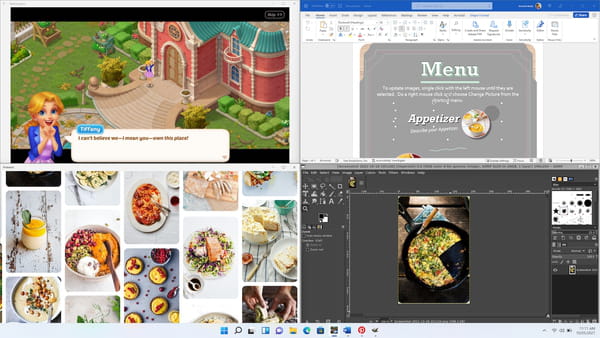Rant! Since the release of Windows 11, Microsoft has been chaining poorly-crafted updates, accumulating problems. It is high time for the publisher to recover to finalize and make its system more reliable, at the risk of losing its users…
But what is happening at Microsoft? Is there still a pilot at the head of the Windows division? We can legitimately wonder when we see how the company and its teams take care of their flagship operating system, which runs hundreds of millions of PCs around the world… In fact, since the release of Windows 11, in October, 2021, it’s big nonsense. We see unfinished versions and badly finished updates which, in general, pose more problems than they solve. Originally promised functions appear somehow, but not for all users, while modules or apps that no one needs appear without warning – and without seducing. Tabs in Notepad? Mazette! A shortcut to mute the microphone? What progress! Adjusting RGB peripherals? We dreamed of it! The return of widgets? Nobody cares ! Seriously, is this really what we expect from an operating system presented as “revolutionary”?
Windows 11: serial bugs from the start
Above all, there are countless reports of more or less blocking bugs that have affected Windows 11 in recent months, especially since the appearance of version 22H2, supposed to fix everything by bringing new functions absent from the first edition (see our article) .Some examples ? They are not missing! We should point out, in bulk, an incompatibility with the Intel Smart Sound Technology (SST) drivers, performance drops with Nvidia graphics cards – as with AMD chips, when Windows 11 was released -, a bug that caused the error blue screen of death (BSOD) with OneDrive, another a bug that created a duplicate print queue by freezing the printer, an issue preventing the lock screen from being closed, installation issues and update with the Microsoft Store, “memory leaks”, or even the inability to install version 22H2, the operation resulting in an error message.
Microsoft recently confirmed an issue with Windows Update KB5019980 which is dated November 2022 causing applications to crash. Admittedly, it had notably corrected six major security flaws and modified the design of the search button on the taskbar. But it had also introduced a major bug with Intel drivers. Even more recently, Patch Tuesday – the set of patches that Microsoft releases on the second Tuesday of each month for all its products – from February 2023 (see our article) signals drivers to be updated, but is unable to download and install them, even crashing the PC! We could multiply the examples of failures with Windows 11, problems that the publisher does not hide since it regularly lists them on a dedicated page…
Each Patch Tuesday thus leads to its share of new problems, which are added to the previous ones before possibly being resolved in parallel patches, sometimes by indirect means, indicated by Microsoft which does not always seem to overcome them. In the end, very clever whoever, without browsing countless pages on Microsoft’s support and information sites, manages to find their way among the many versions and other builds currently in circulation (see our article on builds and the KBs). Only patient, meticulous archaeologists and experts in hieroglyphics can hope to understand something about it…
We could at a pinch admit these permanent failures if Windows were developed and maintained by volunteer amateurs, as is the case with many Linux distributions. But no: Microsoft employs thousands of qualified engineers! Worse: Windows is paying! Certainly, its price is often “transparent”, because the user license is included with the PC. But it’s not free either. Does this mean that the two-year warranty that applies to electronic products – among other things – does not apply to the software that makes them work?
Windows 11: just a Windows 10 revisited
Certainly, not everything is to be thrown away in Windows 11. In addition to the revisited design with windows with rounded corners, we appreciate the integration of tabs in the Explorer – it was about time, when we know that other systems like macOS or Ubuntu have offered this viewing mode for years… – and other small improvements. But let’s be clear, no offense to Microsoft: Windows 11 is not a revolutionary new system. It’s simply a Windows 10 – system name that should have been the last of the family, according to Microsoft when it was launched in 2015… – improved and modernized, but above all tinkered with in a hurry, for obscure reasons – no doubt commercial – just to make people dream with something “new”. So yes, Windows 11 brings a more “current” touch visually. But the new ergonomics and the new functions are still not unanimous, all the more so certain choices – in particular amputations of functions or shortcuts compared to Windows 10 – are perplexing.
To top it off, Microsoft has seen fit to limit the transition to Windows 11 with hardware requirements that are difficult to accept, with a very strict list of accepted processors and, above all, the presence of the famous TMP 2.0 security component: two constraints that have d from the outset prohibits PCs that are fairly recent and perfectly functional from switching to the new system. A choice that is all the more incomprehensible since the pre-versions of Windows 11 worked without any problem on old computers and that Tiny11, a version tampered with and lightened by a clever hacker (see our article) runs without any problem on officially incompatible PCs!
How surprising in these conditions that many users prefer to stay on Windows 10, which still works perfectly? Because, despite Microsoft’s insistence, out of some 1.4 billion devices running Windows worldwide, the “old” system – which dates from 2015 – is still installed on 68% of PCs, against only 17% for new”. That is to say !
And as if all this great shambles were not enough, Microsoft saw fit to add another touch of confusion by announcing the end of the marketing of Windows 10 (see our article), leaving no other choice to those reluctant to Windows 11 than to rush on ISO copies as long as they are available (see our article), on sold-off licenses (see our article), or even, at worst, on pirated versions.
And it’s not over ! To add to the clutter and confusion, Microsoft is constantly adding features to Windows 11 – there is currently talk of a new Explorer engine, which included an image viewer – distilling them and distributing them drop by drop, without any apparent logic, as if each team working on the system was testing in its own corner, releasing its novelties into the wild when it sees fit. Worse still, in its tug of war against Google and the other tech giants, Microsoft has just embarked on a frantic – and rushed – race in artificial intelligence, starting to stuff its AI products a la ChatGPT, from Bing to Microsoft 365 (see our article), even if it means going into a spin (see our article). And we can easily imagine that this popular technology will be at the heart of the next versions of Windows.
Stop!
Windows 11: finish with the permanent construction site
It’s high time that Microsoft got its act together and really focused on quality, instead of trying to sell us permanent innovation in a totally disjointed way. Let’s not forget that an operating system is a bit like a house: it must be complete and functional when delivered. And not in permanent works. What would a buyer say if, on recovering the real estate link he had just acquired, he discovered that everything was still under construction – the kitchen had been repainted but the plumbing was twenty years old, the electricity had only been partially redone, there remains of leaks on the roof… – even though the catalog promised new housing?
The standard user is not asking for the moon: he wants a simple, responsive and reliable operating system that does not require him to change his habits every two months because of the introduction of functions that he does not have unclaimed and which he does not need. How many still today regret Windows XP or Windows 7 because they were more than enough for them? Only geeks always eager for novelties really like to have fun with experimental functions.
It is normal for an operating system to evolve, both to adapt to technological developments and to meet new demands, whether in terms of convenience, functions or security. But it is not enough to repaint the facade superficially, to change the place of the furniture and to add some decorative accessories to renovate a dwelling!
But now, by dint of running after Apple – which has the advantage of mastering software and hardware in its carefully closed ecosystem – Microsoft is scattering in all directions, without keeping a clear course, and without ever finalizing anything. Some time ago, the editor introduced the notion of Moments, pseudo events supposed to mark the introduction of important evolutions of Windows 11. But nobody understands anything about the rhythm and the concept… Instead of distilling functions and often minor new features over the months for no apparent reason – Microsoft should calmly get back to work with more readable objectives, focusing on the essentials and only releasing one large version really finalized per year, which is good sufficient. And if we summarize the grievances of the users that we find on the forms of discussion, we can easily establish the list of what the editor should do.
- Rid Windows 11 of the remains of very old versions, with their old-fashioned interface, which clashes with the pretty effects of the new kid: this is the case of the famous Control Panel, which gives access to certain system functions, sometimes in duplicate, sometimes uniquely, and which is always present, but well hidden (see our article).
- Make the functions and modules present perfectly functional, before adding new, dowdy and often useless ones.
- Stop insistently advertising other Microsoft products in the Start menu or Microsoft Store.
- Cleaning up the range – why so many versions of Windows? – and in updates, so that the average user – and the others! – find themselves there.
- Revise the hardware requirements for Windows 11 instead of trying to impose it by force when many newer and fully functional PCs are incompatible – but they did run pre-releases just fine and they accept newer ones, when you circumvent restrictions.
Is it really too much to ask? No. It’s time Microsoft lived up to its promise to deliver an operating system worthy of its name, its reputation and its users.





